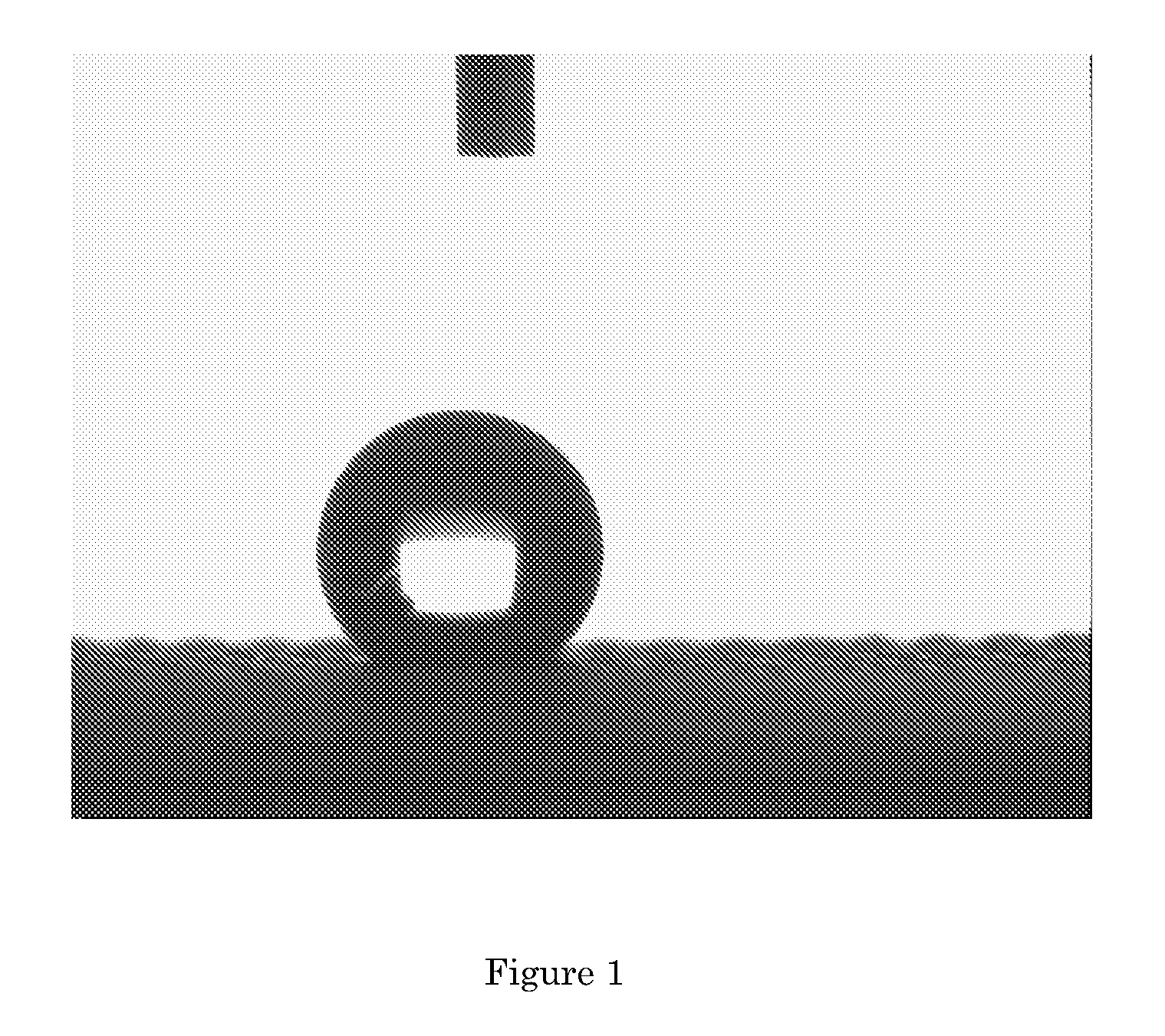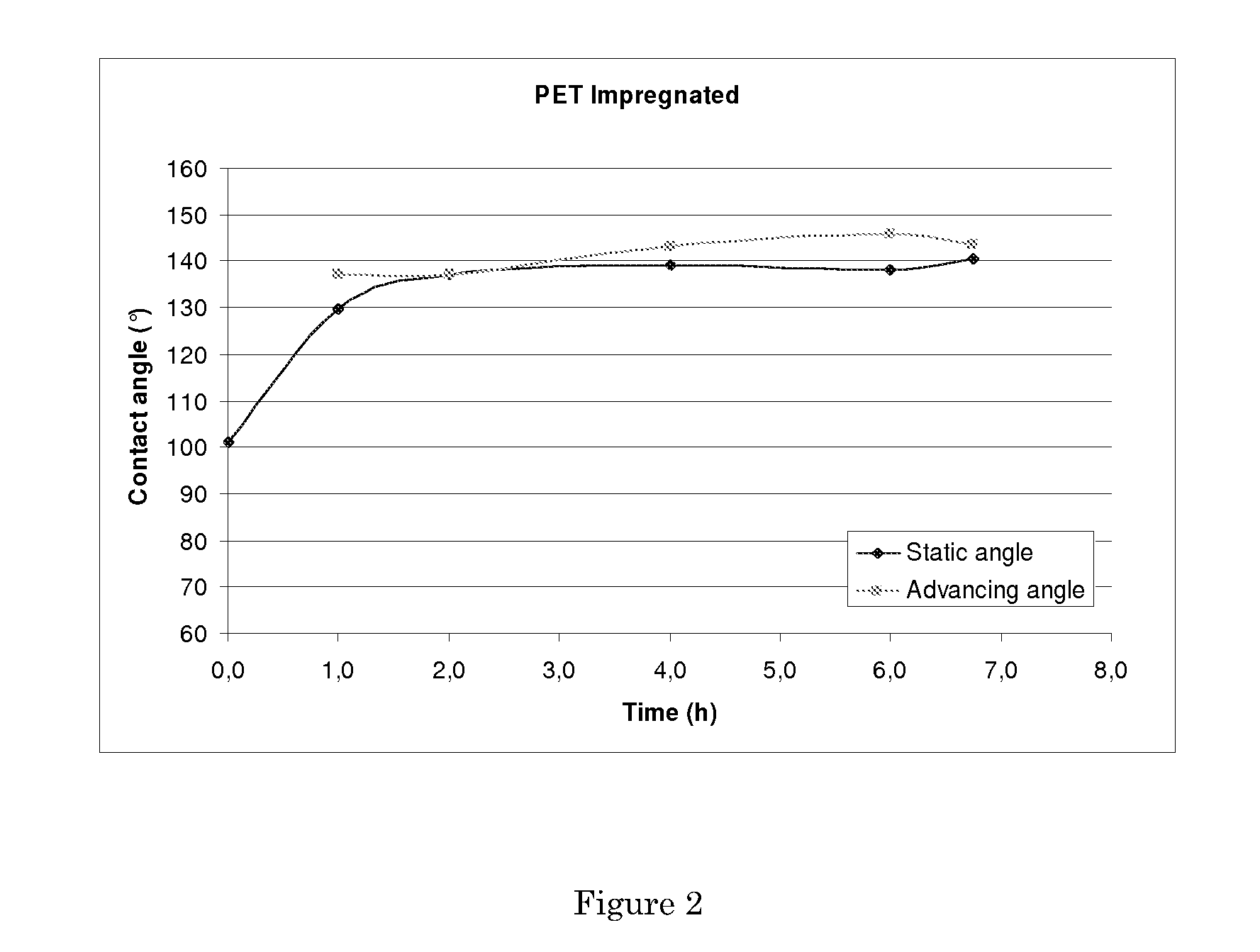Hydrophobic surface finish and method of application
a technology of hydrophobic surface and finish, applied in the field of chemical surface modifications, can solve the problems of reduced durability, increased cost, seams of sailcloth, etc., and achieve the effects of faster equilibrium, higher flow rate, and faster build-up of finish
- Summary
- Abstract
- Description
- Claims
- Application Information
AI Technical Summary
Benefits of technology
Problems solved by technology
Method used
Image
Examples
example 1
[0067]As an Example, the method of the present invention may be performed as follows:
[0068]The surface finish was applied to the sailcloth in one of the last steps of the manufacturing process of the sailcloth, when the sailcloth was ready for confection. The surface was treated with the highly reactive fluorcarbon modified silane, 1h,1h,2h,2h perfluordecyltrichlorosilane with a purity of 97% (Gelest Inc., Morrisville, Pa.). The material was applied in the form of a monolayer, which resulted in only a small increase in weight. The method of gas phase deposition of the fluorinated alkylsilane was essentially performed as follows. An amount of 0.01 liter of the fluorinated alkylsilane was added to the vaporizer. The vaporizer had a volume of 0.1 liter. Nitrogen was used as a carrier gas and was bubbled through the fluorinated alkylsilane liquid to generate a vapor in the headspace of the vaporizer (glass reservoir; volume of liquid of fluorinated alkylsilane 10 milliliter). The fluori...
example 2
[0069]To test whether a pretreatment is needed the sailcloth was untreated or pretreated with a corona plasma torch (corona) or with a sodium hydroxide solution (etching) prior to application of the hydrophobic finish as described in Example 1. Before each (pre)treatment the sailcloth was washed in ethanol (>99%) to clean the cloth and remove possible spin coating residue for one hour. The corona treatment consisted of passing a plasma torch (Tigres Corona table power input 20 Joule per cm2) over the fabric according to manufacturers instructions. The sodium hydroxide treatment consisted of washing the sailcloth (submerged liquid:fabric ratio=30:1 in Linitester rotary cups with 150 ml liquid in each cup) for one hour in 0.5 M sodium hydroxide solution at 90° C. and a subsequent washing with acetic acid (1 gram per liter) and de-mineralized water (see above) to neutralize the cloth.
[0070]Following these pretreatments the sailcloths were dried and subjected to the hydrophobization pro...
example 3
[0076]To measure the durability of the fluorinated alkylsilane coating the sailcloths as prepared above in Example 2 were washed for one hour in de-mineralized water, salt water, toluene and soap. The contact angle was measured before and after the washing process. The reduction of the contact angle was calculated. It is noticed before that the pretreatment had no significant effect on the contact angle. The influence of the pretreatment is still taken into account by the durability tests. As mentioned before the standard deviation is approximately about 0.5 to 1 degrees.
TABLE 4static contact angle of the polyester sailcloth washed with demineralizedwater, salt water, toluene and soap for one hourContactContactPETangleWashangleReductionSailcloth(°)Liquid(°)%Blanco138.5Water129.76.4%Corona139.0Water130.36.2%Etched138.0Water131.84.5%Blanco 1136.7Not washed138.8−1.5%Blanco 2139.1Salt water138.60.4%Blanco 3138.6Toluene134.23.1%Blanco 4139.7Soap133.94.1%
[0077]A reduction in the contact a...
PUM
| Property | Measurement | Unit |
|---|---|---|
| porosity | aaaaa | aaaaa |
| superhydrophobic | aaaaa | aaaaa |
| surface characteristics | aaaaa | aaaaa |
Abstract
Description
Claims
Application Information
 Login to View More
Login to View More - R&D
- Intellectual Property
- Life Sciences
- Materials
- Tech Scout
- Unparalleled Data Quality
- Higher Quality Content
- 60% Fewer Hallucinations
Browse by: Latest US Patents, China's latest patents, Technical Efficacy Thesaurus, Application Domain, Technology Topic, Popular Technical Reports.
© 2025 PatSnap. All rights reserved.Legal|Privacy policy|Modern Slavery Act Transparency Statement|Sitemap|About US| Contact US: help@patsnap.com



